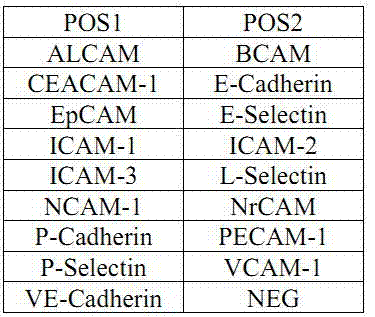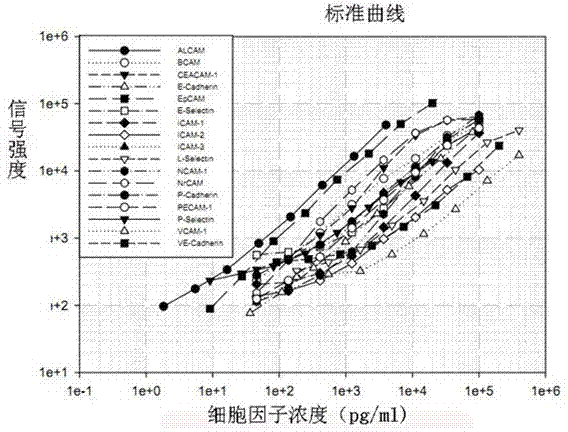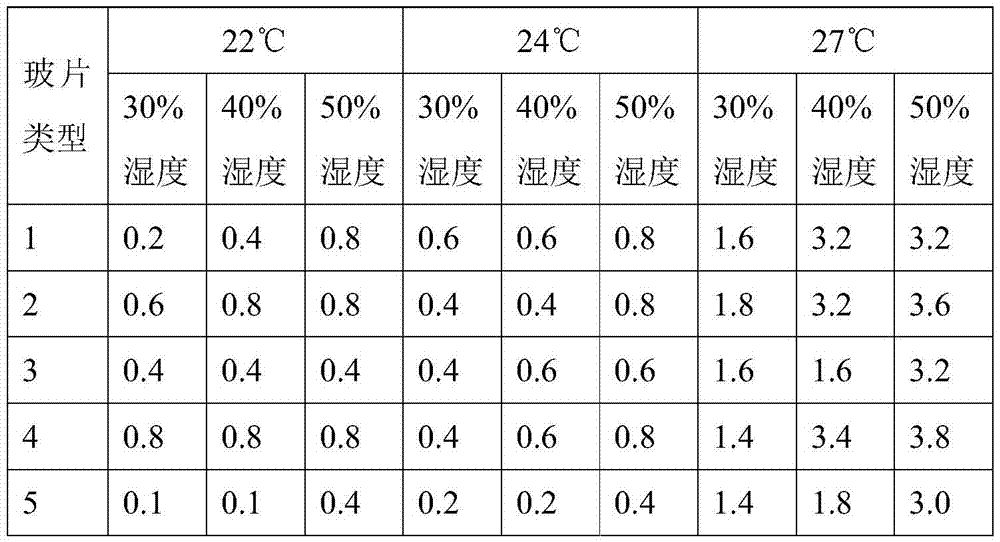Antibody chip kit for detecting cell adhesion molecules
A technology of adhesion molecules and antibody chips, which is applied in biological testing, measuring devices, and analytical materials, etc., can solve the problems of low sensitivity, single detection index, cumbersome operation, etc., and achieve the effect of less sample consumption and high detection sensitivity
- Summary
- Abstract
- Description
- Claims
- Application Information
AI Technical Summary
Problems solved by technology
Method used
Image
Examples
Embodiment 1
[0025] Screening of antibody chip carriers: Conventional antibody chips mostly use nitrocellulose membrane as a carrier. Since the nitrocellulose membrane has a multi-layer structure, it is difficult to wash the chip, resulting in a high background of the chip and large fluctuations in the results. At the same time, the nitrocellulose membrane is fragile, not easy to operate on a large scale, and it is not widely used for large-scale clinical samples. Traditional glass slides are cheap and have low background, which has brought breakthroughs in the widespread use of diagnostic and research fields. We screened the glass slides on the market that were not treated with the active method, and the spotting effect of the glass slides, whether it was aldehydes or aminations, was unstable. After a lot of screening, it is found that the temperature and the active reagent components on the surface of the slide are the key to the effect of spotting on the slide.
[0026] The following 5...
Embodiment 2
[0032] Preparation of an antibody chip kit for quantitative detection of multiple cell adhesion factors at the same time: In order to detect whether there are corresponding receptors in the sample, prepare slides immobilized with specific antibodies corresponding to 17 kinds of cell adhesion factors, 17 kinds of cells The specific antibody corresponding to the adhesion factor is a common commercial product.
[0033] Preparation and storage of the antibody chip: 100-1000 pl of PBS buffer solution containing specific antibodies (containing 0.01-10 g / 100 ml bovine albumin) was spotted on a glass slide with an automatic spotting device. The specific chip array uses biotin-labeled bovine IgG as a positive control. There are four replicate spots in each array for 17 antibodies and two different concentrations of positive controls. In this embodiment, the chip array adopts such as figure 1 The arrangement shown, but in fact, in other embodiments, the chip array can also be combined...
Embodiment 3
[0038] The experimental steps for quantitative detection of adhesion factors with the kit of the present invention are as follows:
[0039] 1. Complete drying of the slide chip: Take the slide chip out of the box, and after equilibrating at room temperature for 20-30 minutes, open the packaging bag, uncover the sealing strip, and then put the chip in a vacuum desiccator or dry at room temperature for 1-20 minutes. 2 hours.
[0040] 2. According to Table 2, carry out gradient dilution of cell adhesion factors
[0041] 2.1. Add 500 μl of sample diluent to the small tube of cell adhesion factor standard mixture, and redissolve the standard. Before opening the vial, give it a quick centrifuge and gently pipet up and down to dissolve the powder. Label this vial as Std1.
[0042] 2.2. Mark 6 clean centrifuge tubes as Std2, Std3 to Std7 respectively, and add 200 μl of sample diluent to each small tube.
[0043] 2.3. Take 100 μl of Std1 and add it to Std2 and mix gently, then take ...
PUM
 Login to View More
Login to View More Abstract
Description
Claims
Application Information
 Login to View More
Login to View More - R&D
- Intellectual Property
- Life Sciences
- Materials
- Tech Scout
- Unparalleled Data Quality
- Higher Quality Content
- 60% Fewer Hallucinations
Browse by: Latest US Patents, China's latest patents, Technical Efficacy Thesaurus, Application Domain, Technology Topic, Popular Technical Reports.
© 2025 PatSnap. All rights reserved.Legal|Privacy policy|Modern Slavery Act Transparency Statement|Sitemap|About US| Contact US: help@patsnap.com



